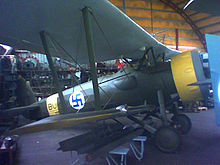Bristol Bulldog
The Type 105 designation was first applied to a subsequent proposal for another aircraft to meet F.9/26 powered by the Mercury engine then under development at Bristol.
[1] The Type 105 was an unequal span single bay biplane powered by a supercharged Bristol Jupiter VII air-cooled radial engine driving a two-bladed propeller.
In order to ensure the maximum field of view there was a large semi-circular cut-out in the trailing edge of the upper wing and the inboard section of the lower was of reduced chord.
It had poor spin recovery characteristics, which were remedied by fitting an enlarged fin and rudder but this led to difficulties in taxiing in a crosswind.
Performance was so close to that of the Hawfinch that a decision was deferred until the aircraft had been evaluated by service pilots; the eventual choice of the Bulldog was made largely because it was easier to maintain.
IIA with revised wing spars and a stronger fuselage, powered by the uprated Jupiter VII F. One production aircraft was modified for use as an advanced trainer: after evaluation by the Central Flying School at Upavon this was ordered by the RAF, the production aircraft differing from the prototype in having slightly swept wings and an enlarged fin to improve spin recovery.
Douglas Bader, better known for his Second World War actions, lost both of his legs when he crashed his Bristol Bulldog while he was performing unauthorised aerobatics at Woodley airfield near Reading.
[9] The Bulldog was exported to foreign air forces, seeing service with Australia, Denmark, Estonia, Finland, Japan, Latvia, Siam and Sweden.
[11] The first aerial victory of the Finnish Air Force was achieved by a Bulldog piloted by SSgt Toivo Uuttu on 1 December 1939,[12] over an I-16.


